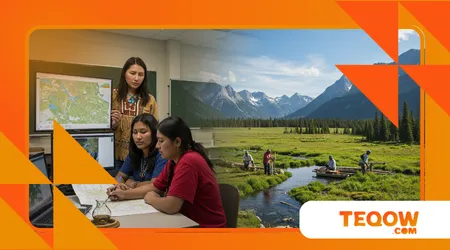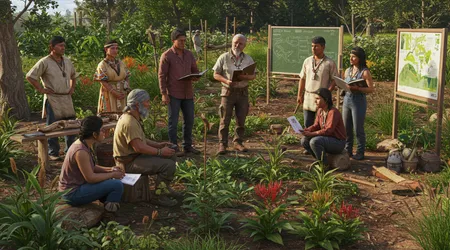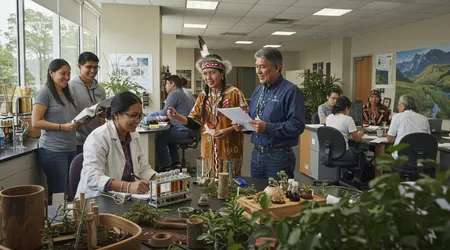New Indigenous Land Stewardship Degrees: Preparing 2025 Graduates for Climate Action

The New Indigenous Land Stewardship Degrees launching across Canadian universities in 2025 mark a pivotal shift in higher education, blending Indigenous knowledge with modern environmental science to equip graduates for climate action.
These programs, rooted in Indigenous worldviews, respond to the urgent need for sustainable land management in a warming world.
They prioritize ecological balance, cultural resilience, and community-led solutions, offering a fresh perspective on tackling the climate crisis.
As Canada faces intensifying wildfires, melting permafrost, and biodiversity loss, these degrees are not just academic they’re a call to action.
Why should the next generation of environmental leaders learn from Indigenous stewardship? Because it’s a proven model for sustainability, grounded in centuries of lived experience.
This article explores how New Indigenous Land Stewardship Degrees are shaping the future of climate action.
From curriculum design to real-world applications, these programs empower students to address environmental challenges through Indigenous-led frameworks.
We’ll delve into their structure, their impact on Indigenous and non-Indigenous students, and their role in fostering reconciliation and resilience.
With practical examples, a key statistic, and a compelling analogy, this piece aims to inform and inspire readers to see these degrees as a cornerstone of Canada’s climate strategy in 2025.
The Rise of Indigenous-Led Environmental Education
Canada’s universities, including the University of British Columbia and the University of Victoria, are rolling out New Indigenous Land Stewardship Degrees in 2025 to address the climate crisis through Indigenous knowledge.
These programs integrate traditional ecological knowledge (TEK) with Western science, creating a holistic approach to land management.
For instance, the University of Victoria’s program includes courses on Indigenous governance, ecological restoration, and climate adaptation, co-designed with local First Nations.
Indigenous knowledge emphasizes relationality humans as part of nature, not above it. This contrasts with Western models often rooted in resource extraction.
New Indigenous Land Stewardship Degrees teach students to prioritize long-term ecological health over short-term gains, drawing on Indigenous practices like controlled burns, which reduce wildfire risks.
The demand for such programs is clear. A 2023 study by the International Institute for Sustainable Development found that Indigenous-managed lands house 80% of global biodiversity, despite covering only 20% of Earth’s territory.
This statistic underscores the effectiveness of Indigenous stewardship, making these degrees timely and essential.
++ Curriculum for Inclusion: Saskatchewan’s Parents’ Bill of Rights and What It Means for Student
Students learn from Knowledge Keepers, Elders, and scientists, blending oral teachings with fieldwork. For example, a course at UBC involves mapping traditional territories with Indigenous communities, fostering skills in GIS and cultural sensitivity.
These programs are not just academic they’re a bridge to reconciliation, embedding respect for Indigenous rights in environmental education.
The rise of New Indigenous Land Stewardship Degrees reflects a broader shift in education. Universities are recognizing that Indigenous knowledge isn’t supplementary it’s foundational.
By centering Indigenous voices, these programs challenge colonial frameworks and prepare graduates to lead with humility and respect.

Curriculum Design: Blending Tradition and Innovation
The New Indigenous Land Stewardship Degrees offer curricula that weave Indigenous philosophies with cutting-edge environmental science.
Courses cover topics like Indigenous law, climate resilience, and sustainable forestry, ensuring graduates are versatile in addressing complex challenges.
For example, a module at Trent University explores Mi’kmaq water protection practices, teaching students to safeguard ecosystems collaboratively.
Practical training is central. Students participate in land-based learning, such as restoring wetlands with Métis communities or monitoring wildlife with Inuit Guardians.
These experiences ground theoretical knowledge in real-world applications, fostering skills in adaptive management and community engagement.
Also read: Provincial Student Aid Boost: Newfoundland & Labrador Raises Grants by 20%
The programs also emphasize Indigenous data sovereignty. Students learn protocols like OCAP (Ownership, Control, Access, Possession), ensuring ethical use of Indigenous knowledge.
This approach respects community rights and counters extractive research practices, a critical lesson for future environmental leaders.
Interdisciplinary learning is another strength. Courses blend ecology, policy, and cultural studies, preparing students for diverse roles in conservation, government, or Indigenous governance.
For instance, a capstone project might involve designing a climate adaptation plan with a First Nation, integrating TEK and policy analysis.
By embedding Indigenous values like reciprocity and respect, New Indigenous Land Stewardship Degrees create graduates who think beyond profit-driven models.
They learn to see land as a relative, not a resource, fostering solutions that honor both people and place.
Empowering Indigenous and Non-Indigenous Students
The New Indigenous Land Stewardship Degrees are inclusive, welcoming Indigenous and non-Indigenous students to learn collaboratively.
For Indigenous students, these programs affirm cultural identity, offering pathways to lead in their communities. For non-Indigenous students, they provide tools to become allies in reconciliation and climate action.
Take Sarah, a fictional Cree student at the University of Saskatchewan. Through her New Indigenous Land Stewardship Degree, she learns traditional plant medicine alongside ecological restoration, empowering her to manage her community’s lands sustainably.
Her capstone project involves reviving a degraded wetland, blending Cree knowledge with scientific methods.
Read more: Canada Expands Student Loan Forgiveness to 10 Rural Health & Social Service Professions
Non-Indigenous students, like fictional character Liam, gain cultural humility. Liam, studying at UBC, joins a field school with the Tsleil-Waututh Nation, learning to respect Indigenous protocols while mapping coastal ecosystems.
This experience shapes his approach to environmental consulting, prioritizing community consent.
These programs foster cross-cultural dialogue, breaking down stereotypes. Students work in diverse teams, learning to navigate complex histories while building trust.
This prepares them for real-world collaborations, where Indigenous leadership is increasingly vital.
Graduates emerge ready to tackle climate challenges with cultural competence. Whether working in policy, conservation, or community development, they carry forward Indigenous principles, ensuring solutions are equitable and sustainable.
Climate Action Through Indigenous Leadership
The New Indigenous Land Stewardship Degrees position graduates as leaders in climate action, leveraging Indigenous knowledge to address urgent environmental issues.
Indigenous communities have long practiced sustainable land management, from Inuit sea-ice monitoring to Haida forest stewardship. These degrees amplify such expertise.
For example, the Indigenous Guardians program, supported by Environment and Climate Change Canada, trains communities to monitor ecosystems.
Graduates of New Indigenous Land Stewardship Degrees can expand such initiatives, using tools like the SIKU app to document environmental changes while respecting Inuit data sovereignty.
Climate policies often overlook Indigenous perspectives, yet these communities face disproportionate impacts.
Graduates are equipped to advocate for inclusive policies, ensuring Indigenous voices shape national strategies like Canada’s 2030 biodiversity targets.
Consider the analogy of a forest: just as diverse species strengthen an ecosystem, diverse knowledge systems Indigenous and Western fortify climate solutions. These degrees cultivate this diversity, producing leaders who innovate with respect.
In practice, graduates might lead projects like restoring caribou habitats with Dene communities or developing renewable energy with Métis organizations. Their work ensures climate action is culturally grounded and effective.
| Program | University | Key Focus Areas | Community Partners |
|---|---|---|---|
| Indigenous Land Stewardship | UBC | TEK, GIS, Reconciliation | Tsleil-Waututh, Musqueam |
| Environmental Guardianship | U. Victoria | Indigenous Law, Climate Adaptation | Nuu-chah-nulth, Songhees |
| Sustainable Land Management | Trent U. | Water Protection, Policy | Mi’kmaq, Anishinaabe |
| Indigenous Ecology | U. Saskatchewan | Plant Medicine, Restoration | Cree, Métis |
Reconciliation and Environmental Justice
The New Indigenous Land Stewardship Degrees are more than educational they’re a step toward reconciliation. By centering Indigenous knowledge, they challenge colonial legacies in academia and environmental management.
They teach students to respect Indigenous rights, like free, prior, and informed consent (FPIC), as outlined in the UN Declaration on the Rights of Indigenous Peoples.
These programs address historical injustices, such as land dispossession, which have fueled environmental degradation.
Graduates learn to support Indigenous-led conservation, ensuring communities regain control over ancestral territories. This aligns with Canada’s 2025 commitment to conserve 25% of lands and oceans.
For instance, a graduate might work with the Haida Nation to protect old-growth forests, combining Haida knowledge with carbon sequestration strategies. Such projects restore ecosystems while honoring Indigenous sovereignty.
Moreover, these degrees foster accountability. Students learn to navigate complex histories, ensuring environmental projects don’t repeat colonial harms. This builds trust between Indigenous communities and institutions.
Ultimately, New Indigenous Land Stewardship Degrees bridge environmental justice and reconciliation, creating a generation of leaders who prioritize equity and Indigenous self-determination in climate action.
Challenges and Opportunities in 2025

Implementing New Indigenous Land Stewardship Degrees isn’t without challenges.
Funding remains a hurdle, as universities must support community partnerships and land-based learning. Ensuring authentic Indigenous leadership in curriculum design is also critical to avoid tokenism.
Yet, opportunities abound. These programs align with Canada’s 2030 climate goals, attracting students eager to make a difference.
They also create pathways for Indigenous youth to lead in high-demand fields like conservation and renewable energy.
Partnerships with organizations like Indigenous Clean Energy (ICE) offer practical avenues for graduates. ICE’s work with Métis communities on solar projects shows how Indigenous knowledge can drive innovation. Graduates can scale such initiatives, blending tradition with technology.
Another opportunity lies in global impact. Indigenous stewardship models are gaining international attention, as seen in UN frameworks. Graduates can influence global climate policy, advocating for Indigenous-led solutions.
By addressing challenges and seizing opportunities, these degrees position Canada as a leader in Indigenous-driven climate education, fostering hope for a sustainable future.
The Future of Climate Leadership
The New Indigenous Land Stewardship Degrees are shaping a future where climate leadership is inclusive and effective.
Graduates will drive projects that restore ecosystems, reduce emissions, and honor Indigenous rights. Their work will ripple beyond Canada, influencing global conservation.
Imagine a graduate leading a coastal restoration project with the Inuit, using traditional knowledge to adapt to rising sea levels.
Or another advocating for Indigenous rights in international climate talks. These scenarios are within reach, thanks to these programs.
As climate impacts intensify, the need for Indigenous-led solutions grows. These degrees ensure graduates are ready to meet this moment, blending ancestral wisdom with modern tools.
They’re not just learning they’re redefining environmental leadership.
In 2025, Canada stands at a crossroads. Will we continue with fragmented climate strategies, or embrace Indigenous knowledge as a cornerstone?
The New Indigenous Land Stewardship Degrees point to the latter, offering a path to resilience and reconciliation.
Conclusion: A Call to Action for 2025 Graduates
The New Indigenous Land Stewardship Degrees are a beacon of hope in 2025, equipping graduates to tackle the climate crisis with wisdom, respect, and innovation.
They blend Indigenous knowledge with modern science, fostering leaders who prioritize ecological and cultural resilience.
From restoring wetlands to shaping inclusive policies, graduates will drive meaningful change. These programs are not just about education they’re about building a future where Indigenous leadership guides us through the climate storm.
As Canada commits to ambitious climate goals, these degrees offer a blueprint for action. They empower students to bridge divides, honor Indigenous rights, and protect the planet.
For those considering a career in environmental stewardship, these programs are a chance to make history. Enroll, engage, and lead because the Earth, and its first stewards, need you now.
Frequently Asked Questions
What are New Indigenous Land Stewardship Degrees?
They’re university programs launching in 2025, blending Indigenous knowledge and environmental science to train students for climate action and land management.
Who can enroll in these programs?
Indigenous and non-Indigenous students are welcome, with curricula designed to foster cross-cultural learning and respect for Indigenous rights.
How do these degrees support climate action?
They teach sustainable practices, like Indigenous-led conservation, equipping graduates to address issues like wildfires, biodiversity loss, and rising sea levels.
Are these programs practical or theoretical?
They combine theory (e.g., Indigenous law) with hands-on learning, like wetland restoration or wildlife monitoring with Indigenous communities.
How do these degrees contribute to reconciliation?
By centering Indigenous knowledge and rights, they challenge colonial legacies, fostering equitable partnerships and supporting Indigenous self-determination in environmental management.
